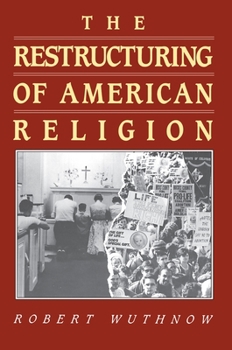The Restructuring of American Religion: Society and Faith Since World War II
Select Format
Select Condition 
Book Overview
The description for this book, The Restructuring of American Religion: Society and Faith since World War II, will be forthcoming.
Format:Paperback
Language:English
ISBN:0691020574
ISBN13:9780691020570
Release Date:January 1990
Publisher:Princeton University Press
Length:392 Pages
Weight:1.25 lbs.
Dimensions:0.9" x 6.1" x 9.2"
Customer Reviews
2 ratings
Landmark book setting the terms for debate on Moral Politics
Published by Thriftbooks.com User , 19 years ago
Wuthnow is clearly of the conviction that American religion has undergone a serious change since WWII. At the end of WWII, Wuthnow believes common assumptions about religion existed. First, it was Biblically-based, congregational, but with indivdualistic tendencies. 2 out of 3 persons attended a church once a month or more, and 42% attended every week. "Protestant, Catholic, or Jew" was the main question. After WWII, the dominant mode of religious institutions interacting with the larger society was to instruct and inspire individuals. A comcommittent focus on ethics, social justice as part of the larger sense of declaring Christian principles. A spirit of public evangelism and private education held sway, not the least as an indirect demonstration of political muscles. As education became increasingly common and with it the growth of the state, religious institutions adapted by forming and expanding educational curricula of their own. The emphasis on education was given two emphases. From the conservative side beliefs and the process of arriving at those beliefs became a standard for the articulation of genuine values. Liberals in turn tended toward not the content of beliefs, but rather a procedural validation of the process of coming to a set of beliefs. In the 1950's, these divisions began forming, even as all kinds of denominations exploded in growth. According to Wuthnow, perhaps one of the most important developments in 20th century American religious life has been the development of special purpose groups. These groups grew from a few dozen after the Civil War to about 150 at the turn of the century. Since from 1960 to the 1980's, about 300 were formed, bringing the post-WWII total to around 500. This is not remarkable when compared with other nonprofit and voluntary associations, many of which have grown more than religious ones. But in comparsison with religious denominations, it has been spectacular growth overall. General levels of affluence and leisure time have provided the fuel for growth. Wuthnow argues though, that both directly and indirectly, the State is the biggest factor in the growth of such associations, as different groups seek to encourage, restrain, or influence particular aspects of civil policy and state growth. At the same time, Wuthnow also draws attention to the disillusionment in government brought through the Vietnam War, Watergate, and the Roe vs. Wade decision. He argues that the subsequent rise and popularity of morality as a public issue and its intimate connection to government and policy helped legitimate the rise of the political evangelicals, even as the denominational hierarchies were increasingly dominated by theological liberals. Conservative evangelicals took advantage and built the public terms of a debate in which their morals and values were assumed to be part of the national spotlight and the national debate, while arguing that in the field of morality liberals were either absent altogether or
A seminal work on American religious history
Published by Thriftbooks.com User , 23 years ago
Wuthnow's book is a thoughtful and well-researched monograph on major trends in American religious experience since the end of World War II. Wuthnow sees the most significant change as being a decline in the denominational divisions that were once so important in American religious life, and their replacement by a huge chasm between liberal and conservative religious sensibilities, a division Wuthnow points out often cuts as much through denominations as separates them. Perhaps his most important contribution is his effort to place this restructuring in the context of larger trends in American society, notably the divisive politics and cultural innovation of the sixties, the changing role of women and the trememdous expansion of higher education that occurred after World War II. He also notes a degree of continuity between the conservative versus liberal division and the early twentieth-century fundamentalist-modernist conflict within American religion. He is careful, though, to explain and contextualize the greater success the evangelical Christian movement has had in building a movement and mobilizing followers than did the earlier and in many ways similar fundamentalist camp. Perhaps one's only caveat here might be that the book raises many questions it does not fully address about the extent to which American culture is becoming genuinely secular, if it is doing so. Written at a high level of generality, the book also leaves one wondering about how the division of religious life into polarized camps of liberalism and conservativism affects the subjective spiritual experience of Americans. In brief, this book is a major and analytical treatment of a topic that remains very germane to how Americans now live and worship; those desiring to understand how American religion got where it is today should read it.





